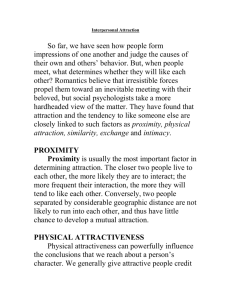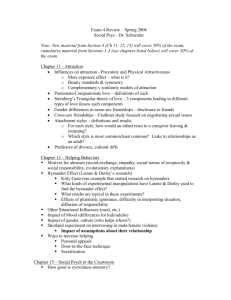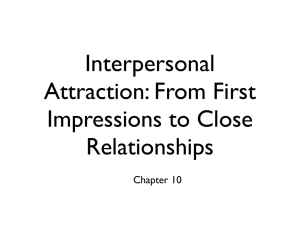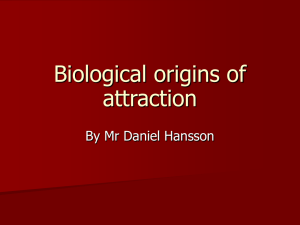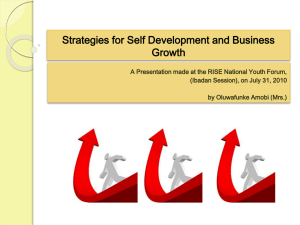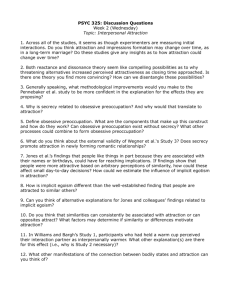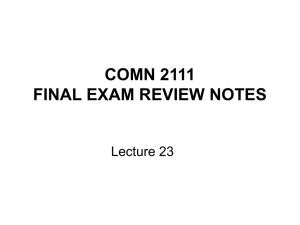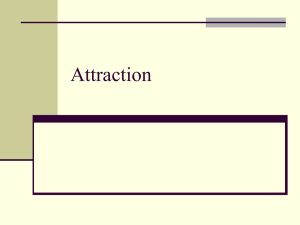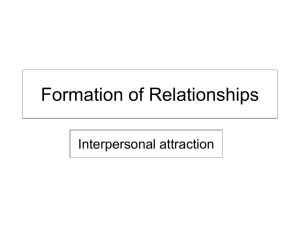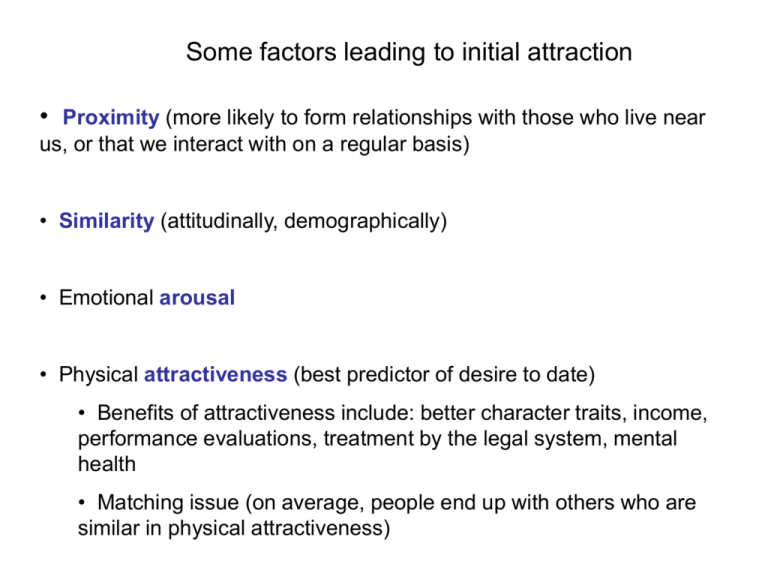
Some factors leading to initial attraction
• Proximity (more likely to form relationships with those who live near
us, or that we interact with on a regular basis)
• Similarity (attitudinally, demographically)
• Emotional arousal
• Physical attractiveness (best predictor of desire to date)
• Benefits of attractiveness include: better character traits, income,
performance evaluations, treatment by the legal system, mental
health
• Matching issue (on average, people end up with others who are
similar in physical attractiveness)
“Bridge” Study
Misattribution of Emotional Arousal
Anxiety, when paired with an attractive person (cue), can lead to the
labeling of one’s emotional state as sexual attraction.
Attitude Similarity and Attraction
How does attitude similarity affect attraction?
Byrne and Nelson (1965) asked subjects to rate how much they liked a stranger
after learning he agreed with varying proportions of their attitudes expressed
on a questionnaire. (Higher numbers indicate greater liking.)
13.00
12.00
Attraction 11.00
Toward
Other person 10.00
9.00
8.00
7.00
6.00
.00
.20
.40
.60
.80
1.00
As the graph shows, the greater the proportion of attitudes subjects shared with
the stranger, the more subjects liked or were attracted to the stranger.
Why Similarity is Attractive
• Social validation – (similar others will support our beliefs)
• Cognitive Consistency --- (e.g., we like ourselves, and we like
someone who is similar to us)
• Predict, anticipate the desires of others (e.g., their preferences
regarding what do on a date)
• They will probably like us back (cost/benefit assessment)
Repulsion Hypothesis of Attraction
Premise --• Similarity does not add significantly to attraction
• Differences are disliked; people who are different are avoided
Similar Other
Neutral
reaction
Dissimilar Other
Negative
reaction
Our Own Attitude
Consistent with other theories (e.g., equity theory, balance theory,
congruity theory, dissonance theory). When things are “off” we are
motivated to restore equilibrium.
Misattribution of Friendly Behavior
Males and females engaged in a 10 minutes conversation about school-related topics
• Overall, males saw the interaction as sexual in nature
• Male participants and male observers viewed the female as promiscuous
• Male participants viewed themselves as flirtatious and seductive
• Male observers viewed the male participant as flirtatious, seductive, and being
attracted to the female
Equity Theory
Inputs (Costs -- e.g., time, effort)
Outputs (Rewards – e.g., security, respect, sexual fulfillment)
Comparison Other (s) -- Compare inputs/outputs to:
• Other people
• Oneself in the past
• An idealized image
Comparison Level for Alternatives
The Life Cycle of a Relationship
Levinger (1980, 1983) describes five stages in the life cycle of relationships.
As the relationship moves through the stages, it is affected by different
variables and characterized by different degrees and kinds emotions.
Continuation/
consolidation
Buildup
Attraction
Important
variables
influencing
attraction
Emotion
Triggering factors:
Proximity
Similarity
Erotic love
Etc.
High:
Heady feeling
of romantic love
Relationship
continues
Deterioration
and decline
Ending
Social-exchange and equity:
Communication
Self-disclosure
Communal concern
External supports
Low:
Relationship in
stable state
Social-exchange and
Equity/inequity:
Relative attractiveness
Of alternatives
Barriers to dissolution
High:
Upset of deterioration
And trauma of disruption
Recent Relationship Research --- Key Points
• One’s thoughts about social interactions
• Discovering similarities and differences (naturally)
• Searching out others and detecting information
• Evaluation of the process (good/bad)
• Strategies, plans
• Future projections
• Timing and sequencing of events and information
• Narratives (e.g., stories) about relationship interactions
• Who is told?, When are stories told?, What is told?
• Different accounts of actual events (rich source of information)

